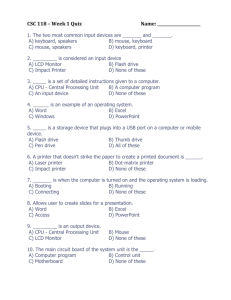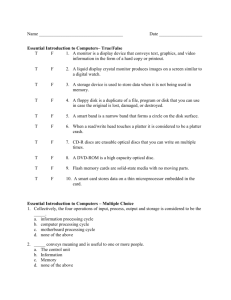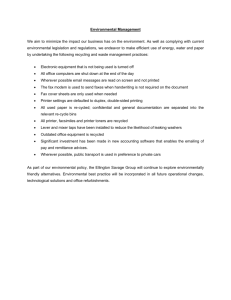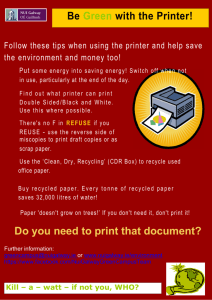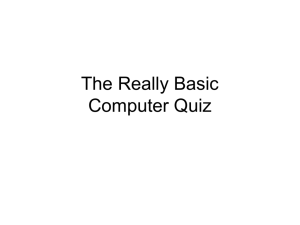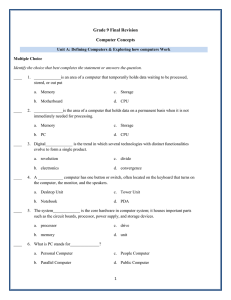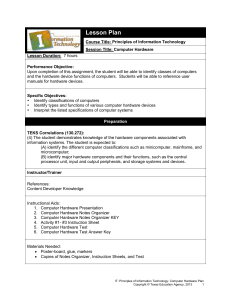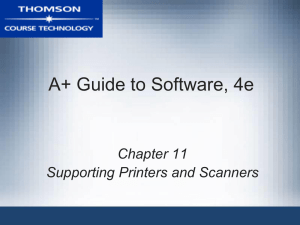Introduction to Computers
advertisement
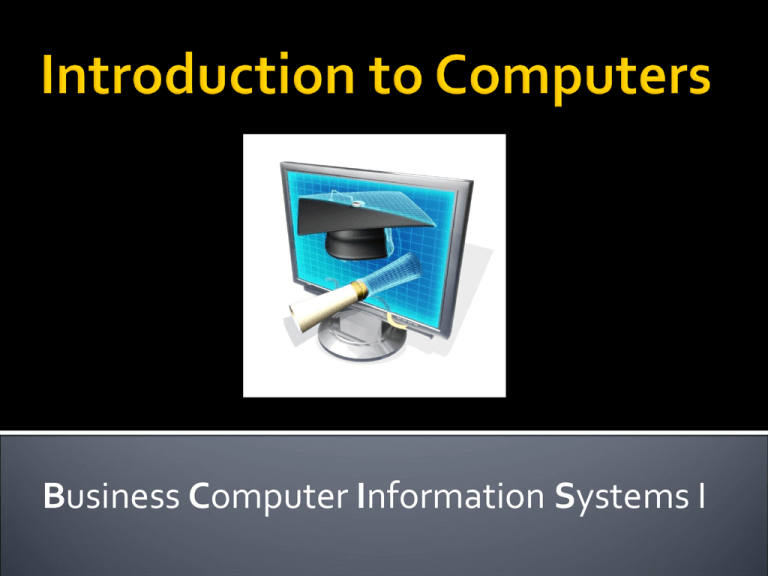
Business Computer Information Systems I Knowing how to use a computer is a basic skill necessary to succeed in business or to function effectively in society. Use of computer technology is widespread in the world. Knowing how to use common Application Software is an essential skill for practically everyone. An electronic device, operating under the control of instructions stored in its own memory unit, that can accept data (input) manipulate the data according to specified rules (process) produce information (output) from the processing store the results for future use. Generally the term is used to describe a collection of devices that function together as a system. Monitor (output) Speaker (output) Keyboard (input) Mouse (input) System Unit (processing, memory and storage) Modem (communications) Printer /Scanner(output) Hard disk drive (storage) Flash drive (storage) CD-ROM/DVD-ROM Drive (storage) Computers can perform four general operations. Input Processing Output Storage These operations comprise the information processing cycle All computer processing requires data input. Data – The raw facts including numbers, words, images, video, and sounds given to the computer during the input operation. Computers manipulate data to create information. Information – data that is organized, has meaning, and is useful. During the output operation, the information created is put into some form, such as a printed report, an invoice, a web page, or a paycheck. The operations occur through the use of electronic circuits contained on small silicon chips (microchips) inside the computer within billionths of a second. It must be given a detailed set of instructions (computer program or software ) that tells it exactly what to do. Programs are stored in the computer. The computer can begin to operate by executing the program’s first instruction. It executes one program instruction after another until the job is complete. CENTRAL PROCESSING UNIT (CPU) INPUT DEVICES MEMORY STORAGE DEVICES OUTPUT DEVICES Allow you to enter data, programs, commands, and user responses into a computer. Keyboard – primary Mouse – primary Scanners Reading devices Digital cameras Audio and video input devices Devices for the physically challenged users Contains the electronic circuits that cause processing to occur. Control unit – interprets the instruction Arithmetic/logic unit – performs the logical and arithmetic processes. Designed into a chip called a microprocessor. Called Random Access Memory – RAM, consists of electronic components that store data including numbers, letters of the alphabet, graphics, and sound. Measured in Kilobytes (1 thousand memory locations), Megabytes (1 million) Gigabytes (one billion), Terabyte (1 thousand billion) Petabyte (one thousand terabytes), etc. A Byte is a basic unit of memory measurement. Printers (hard copy) Ink-jet printer – nozzle that sprays drops of ink onto the page Laser printer – use a process similar to a copying machine. Photo printer – creates photographic output Monitors - TV-like display device CD-ROMs – used to store large amounts of prerecorded information. Hard Disks – housed permanently inside the system unit—not portable. DVD-ROMs – very high capacity compact disc capable of storing from 4.7 GB to 17 GB Flash Drives (Pen Drives) - High capacity, removable storage devices System Software – programs to control the operations of computer equipment. Operating System – Set of programs instructing the computer on how to perform the functions of loading, storing, and executing an application program. Microsoft Windows XP Application Software – programs that tell a computer how to produce information. MS Word, Excel, Access, PowerPoint, Outlook Word Processing – used to create, edit, format, and print documents. MS Word 2007 Spreadsheet – allows the user to add, subtract, and perform user-defined calculations on rows and columns of numbers. MS Excel 2007 Database – allows the user to enter, retrieve, and update data in an organized and efficient manner. MS Access 2007 Presentation Graphics – allows the user to create documents called slides to be used in making presentations. MS PowerPoint 2007 Network – a collection of computers and devices connected together via communication media and devices that share hardware, software, data, and information. The Internet – largest worldwide collection of networks that links together millions of computers by means of modems, telephone resources, satellites & data. WWW – popular segment of the Internet URL – Uniform Resource Locator -unique address of a Web page (protocol, domain name and path) Determine what application software products you will use on your computer. Before buying a computer system, do some research. Speed of processor Size and types of memory and storage Input/output devices Communications devices Overall system cost (cheapest isn’t always the best) Stick with brand names Do comparison shopping



